Winds of change at private sector banks
ADVERTISEMENT

This is a period of change at the top managements of the private sector banks in India. In fact, FY19-21 is being seen as the phase when banks, together controlling as much as 77% of the total private loan market share, will see changes in their top management. It’s already happening: some of the country’s largest private sector banks – ICICI Bank, Axis Bank and YES Bank, have seen new faces enter the corner office, for very different reasons. Now, the market is keenly watching the developments at two other top-notch private sector banks -- HDFC Bank and IndusInd Bank -- which are due for changes at the top.
A detailed report on the subject by financial house Motilal Oswal points out that this phase of change is very significant for markets and the financial sector in general since these banks have seen CEOs who are known to have built these banks, or led them for over a decade. Already, allegations of financial misdemeanour by former CEO Chanda Kochhar at ICICI Bank have led to her stepping down and Sandeep Bakhshi being appointed in her place. Axis Bank saw Shikha Sharma’s term being cut short by the Reserve Bank of India and Amitabh Chaudhry succeeding her, while at YES Bank, promoter Rana Kapoor made way for Ravneet Gill, who came in from Deutsche Bank.
While these three changes weren’t really anticipated by the markets, the bourses will now be keenly watching who replaces two iconic bankers – Aditya Puri and Romesh Sobti, at HDFC Bank and IndusInd respectively. Both bankers have been known to have contributed immensely to making their banks blue-chip market favourites and have been leading these institutions for many years. Sobti and Puri are slated to retire in March, 2020, and October, 2020, respectively.
January 2026
Netflix, which has been in India for a decade, has successfully struck a balance between high-class premium content and pricing that attracts a range of customers. Find out how the U.S. streaming giant evolved in India, plus an exclusive interview with CEO Ted Sarandos. Also read about the Best Investments for 2026, and how rising growth and easing inflation will come in handy for finance minister Nirmala Sitharaman as she prepares Budget 2026.
“Over the past 25 years, under the leadership of Aditya Puri, HDFC Bank has grown to become the largest private bank with a systemic market share of 8.4% and market capitalisation of ₹6.3 lakh crore – more than the sum of next two largest private lenders. This was enabled by steady 32% CAGR in earnings over past two decades thus placing HDFC Bank amongst the best in the banking industry. This underscores contribution of the top management across business cycles,” the Motilal Oswal report points out.
“IndusInd, on other hand, is a well-executed transformation story under the leadership of Mr. Romesh Sobti who has made immense contribution to the bank.”
The report adds that such changes in top management aren’t just management changes but often lead to a total change in the bank’s identity. Examples are Chaudhry’s fresh start at Axis last year, the major changes Sobti brought about from 2008 when he took over at IndusInd (then a struggling bank), P.J.Nayak’s leadership from 2000 at Axis (earlier UTI Bank) and, more recently, Vishwavir Ahuja’s style of leadership which completely transformed the community-oriented Ratnakar Bank into new-age private sector lender RBL Bank from 2010.
The Motilal Oswal report, however, also raises the question about whether, in the context of this imminent change in leadership at two of the country’s top private sector banks, RBI would once again look at the issue of retirement age of the CEOs. It may be recalled that in 2014, the central bank raised the retirement age of a bank’s MD & CEO from the earlier 65 years to 70 to align it with the Companies Act, 2013. The Act also has a provision whereby a company can, by way of a special resolution, allow a person over 70 to continue as a director. The question the Motilal report raises is whether the RBI will now harmonise the banking regulations with this element of the Companies Act.
“In the U.S., the maximum retirement age for a CEO is 72 years with companies having the right to prescribe lower retirement age. Nearly 75% of the global S&P 500 firms have by-laws that require CEOs to retire at or before 65 years of age. According to the corporate governance policy of two large US banks — JP Morgan and Morgan Stanley – the retirement age for a CEO is set at 72 years,” the report adds.
It also says that the concerns pertaining to the management change in HDFC Bank/IndusInd Bank have already started to creep in as evident from their respective stock prices. Both HDFC Bank/IndusInd have given 22%/-1% returns in the past one year as against 25% returns in Bank Nifty. For IndusInd, the under-performance was aggravated also due to concerns on its IL&FS exposure.
Barring ICICI Bank, both Axis and YES have opted for outsiders to succeed the outgoing CEOs. At IndusInd, Sobti’s stature is unmatched within the bank, while at HDFC Bank, while Paresh Sukthankar had been earlier elevated to Deputy MD, his resignation, the report notes, has also increased the possibility of an external candidate coming in to head the bank after Puri retires.
Not surprisingly, given the wealth these two banks have created for shareholders, the bourses are following every move in these institutions very minutely.
